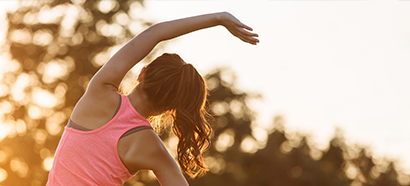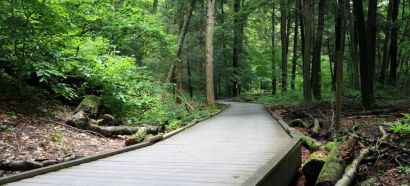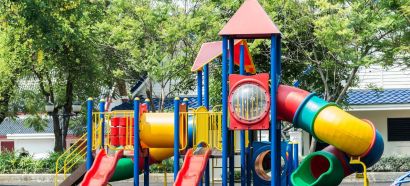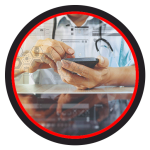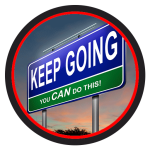Current state of Readiness: Action
Individuals have made intentional lifestyle modifications.
Our Goal: To keep you motivated and on track.
Featured Videos & Articles
Typical Workout
- Warm Up
- Cardio
- Resistance Training
- Cool Down
- Stretching/Flexibility Exercises
The Warm-Up
Stretching is not warming up!
A proper warm-up should raise your body temperature by one or two degrees Fahrenheit.
The warm-up should begin with joint-rotations, starting either from your toes and working your way up, or from your fingers and working your way down.
Joint Rotations
- Slow circular movements in both direction.
- Results in lubrication of the entire joint.
Joint Rotation Sequence
- Fingers and knuckles
- Wrists
- Elbows
- Shoulders
- Neck
- Trunk/waist
- Hips
- Legs
- Knees
- Ankles
- Toes
Cardio
- An activity that raises your heart rate
- How long should you do cardio
- Typically cardio is done for 30+ minutes
- Real answer depends on the amount of calories you need to burn and the intensity of your workout
- Heart Rate
- Max Heart Rate:
- Highest number of times your heart can contract in one minute
- Formula
- Max Heart Rate = 220 – age
- Targets
- Light Exercise: 50% – 60%
- Weight Lose: 60% – 70%
- Aerobic Endurance: 70% – 80%
- Elite Athlete: 80% +
- Example
- 40 yr old desiring to lose weight (65% of Max Heart Rate)
- (220 – 40 = 180 ; 180 x 65% = 117 beats per minute)
- Max Heart Rate:
- Intensity
- Moderate:
- 40-60% of max heart rate
- Slightly increased rate of breathing
- Feels “light” to “somewhat hard”
- Can easily carry on a conversation
- Example: Walking
- Vigorous:
- Above 60% of your max heart rate
- Increased rate of breathing
- Sweating
- Feel “somewhat hard” to “very hard”
- Example: jogging, power walking, endurance sports
- Moderate:
- Pulse
- Pulse: rate at which your heart beats
- Usually called your heart rate (number of times your heart beats each minute)
- Your pulse can be felt as blood passes through your arteries
- Check your pulse
- Place the pads of these three fingers just below the wrist creases at the base of the thumb
- Press lightly until you feel a pulse (blood pulsing under your fingers)
- Count the beats you feel for 15 seconds and multiply this by four to get your heart rate per minute
- Use a watch or clock with a second hand
Resistance Training
Any exercise that causes the muscles to contract against an external resistance
Common terminology
- Repetition or “rep”: One complete movement of a exercise
- Set: A group of reps
Way to reach your desired results:
- Muscle Mass/Strength: 6-8 reps 4 sets
- Tone/Endurance: 12-15 reps 4 sets
Sample: Upper Body Workout
- Chest: Chest Press, Fly, Chest Squeeze, Push Up, Dip
- Back: Bent-Over Row, Hyperextensions, Reverse Fly
- Shoulders: Shoulder Press, Dumbbell Raise Front, Dumbbell Raise Side
- Arms: Biceps Curl, Hammer Curl, Wrist Curls, Triceps Extension, Kickbacks
Sample: Lower Body Workout
- Legs: Squat/Pile Squat, Lunge, Stiff Leg Dead Lift, Step-Up + Knee Lift, Hip Abduction, Butt Clenches, Thigh Squeeze, Calf Raises
Sample: Core Workout
- Stomach: Ab Squeezes, Crunch, V-Sit Pull-Back, Plank, Wipe-Away, Side Scissors Crunch, Butterfly Chest Lift
Cool Down
- Perform light cardio exercise
- Example: 5 to 10 minutes walking
- Benefits:
- Decrease body temperature
- Remove waste products from the working muscles
- Reduce the chances of dizziness or fainting caused by the pooling of blood at the extremities
- Allows the heart rate to return to its resting rate
Stretching and Flexibility
Stretching: Actively working to lengthen your muscles
Flexibility: The ability to bend and move through the complete range of movement in a joint
Benefits include:
- Increases flexibility
- Improves range of motion of your joints
- Improves circulation
- Relieves stress and promotes mental and physical relaxation
- Enhances body awareness
- Reduces risk of injury to joints, muscles, and tendons
- Reduces muscular soreness
The Correct Way to Stretch
- Assume a position and then hold it there with no assistance
- Don’t bounce. Bouncing can cause small tears in the muscle
- Expect to feel tension, but if it hurts, you’ve gone too far
How Long to Hold Each Stretch?
- Adults: 20-30 seconds
- Youth: 7-10 seconds
Breathing
- Take slow, relaxed breaths
- Proper way to breathe:
- Inhale slowly through the nose, expanding the abdomen (not the chest), hold the breath a moment, then exhale slowly through the nose or mouth
Static Stretching Sequence
Assume a position and then hold it there with no assistance
Sequence: Back, Sides, Neck, Forearms and wrists, Triceps, Chest, Buttocks, Groin, Thighs, Calves, Shins, Hamstrings, Instep
Workout Routine Recap
- Warm Up
- Joint Rotations
- Slow circular movements in both direction
- Start either at your toes or fingers and work your way through your entire body
- Result: joint lubrication
- Joint Rotations
- Cardio
- Walking, running, bicycling, swimming, dancing, aerobics
- Example: (walking)
- Warm up by going slow and easy (2 min)
- Increase the pace (bigger/faster strides) (3min)
- Slow down slightly (2 min)
- Repeat steps 2&4 (3 times)
- Cool down by going at an easy pace (3 min)
- Resistance Training
- Perform 3 sets (series) of each exercise for 12 to 15 repetitions
- Do not workout the same muscle group 2 consecutive days
- Example routine: (5 days a week)
- M: Upper body (chest, shoulders, triceps)
- T: Cardio and Abs
- W: Lower body
- Th: Cardio and Abs
- F: Upper body (back, biceps, forearms)
- Cooldown
- Helps the heart rate and respiration slow down gradually
- Helps avoid dizziness/fainting and allows your muscles to recover
- Slow down and cool off, but continue moving until you’re not sweating anymore and your skin is cool to the touch
- Use this time to sip water and rehydrate.
- Stretching/Flexibility Exercises
- Slow and controlled, without bouncing
- Benefits: Increased range of motion, aid in workout recovery, decrease muscle soreness, and reduce likelihood of future injury



